Menu
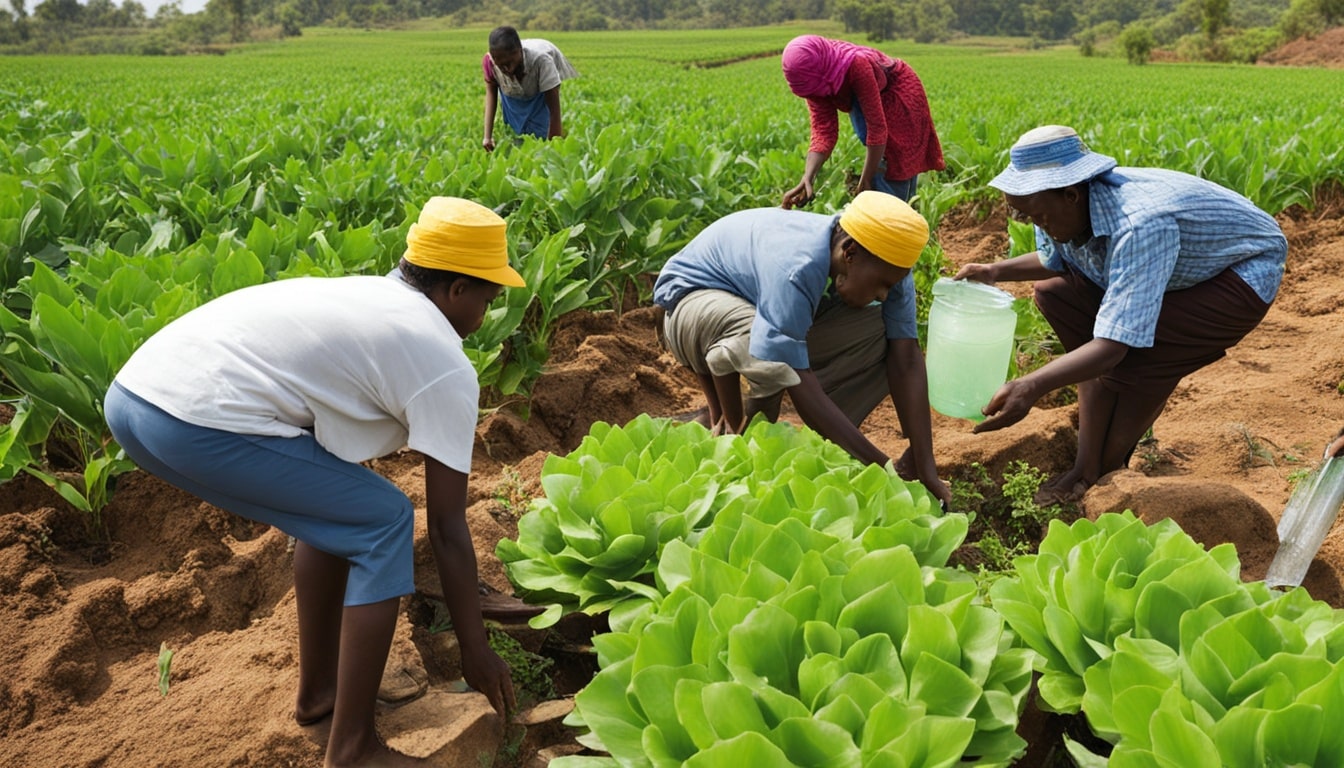
Did you know more than 90 percent of disasters are linked to water? And that 40 percent of the world is facing water scarcity? These facts show why we need good water management for the future. It’s a big deal for making sure we have water that’s both reliable and adapts to changes. This work brings many people together to plan, like researchers, government leaders, students, farmers, and nature protectors.
We look at problems in specific places, like the San Joaquin Valley in California, the Mesilla Valley in New Mexico, and Cache Valley in Utah. But, we also think about how to help all over the world. By doing this, we hope to find ideas that can work everywhere, helping not just local areas but also places that struggle with water around the globe.
Climate-resilient water management aims to boost water systems’ ability to handle climate change’s impacts. It encourages using water wisely and sharing it fairly. This helps manage challenges from climate changes, growing cities, and more people needing water. For lasting good water use, we need to protect our water sources. They are essential for life, business, and making food and energy.
Climate-resilient water management makes water systems tougher against climate extremes. It mixes sustainable water practices and new ways to cope. By working together, communities secure a steady water supply, even in tough times. This teamwork is key, especially when water flows between countries, making shared water efforts vital.
Today, looking after our water amid climate change matters more than ever. To make water safe worldwide and manage it well (SDG 6), we need 114 billion USD yearly. This huge number shows the big effort and money needed. Yet, just 2.6% of what was spent in 2016 on fighting climate change went into water. We must change this focus and invest more in water security.
The 2023 UN Conference will be a big step since 1977, working on global water challenges. It aims to put in place goals supporting the Paris Agreement. It shows how urgent climate adaptation in water resources is. This meeting is key for boosting investment in better water data, rules, learning, and power. It’s a chance to fully protect our water for the future.
| Investment Area | Funds Allocated (2016) |
|---|---|
| Total Climate Change Initiatives | 455 billion USD |
| Water Management | 0.7 billion USD |
| Total Funding by Green Climate Fund, Global Environment Facility, and Adaptation Fund | 51 billion USD |
Climate change hugely affects water. It changes how water moves and makes it harder to find. This shows why we need strong water systems. I’ve seen how most disasters are linked to water issues. We must connect water and climate policies to solve these problems.
Changes in rainfall and how water evaporates are direct effects. They make fresh water scarce. Surprisingly, only a tiny bit of Earth’s water is usable like this.
Climate change also makes it harder to manage water. Over the years, we’ve seen places lose the ability to store water. This affects nature and people, making it tough to cope with less water.
Worldwide, more people will face water shortages by 2050. Around 3 billion will live in dry areas. And floods will put 400 million more at risk.
In some parts of the world, water bodies are shrinking or growing quickly. This is a clear sign of climate change. In the US, heavy rain has increased since 1901 and will keep increasing. Older water systems are not ready for these changes.
“The current Arctic sea-ice cover, now at its lowest level since at least 1850, is projected to reach nearly ice-free conditions at its summer minimum before 2050.”
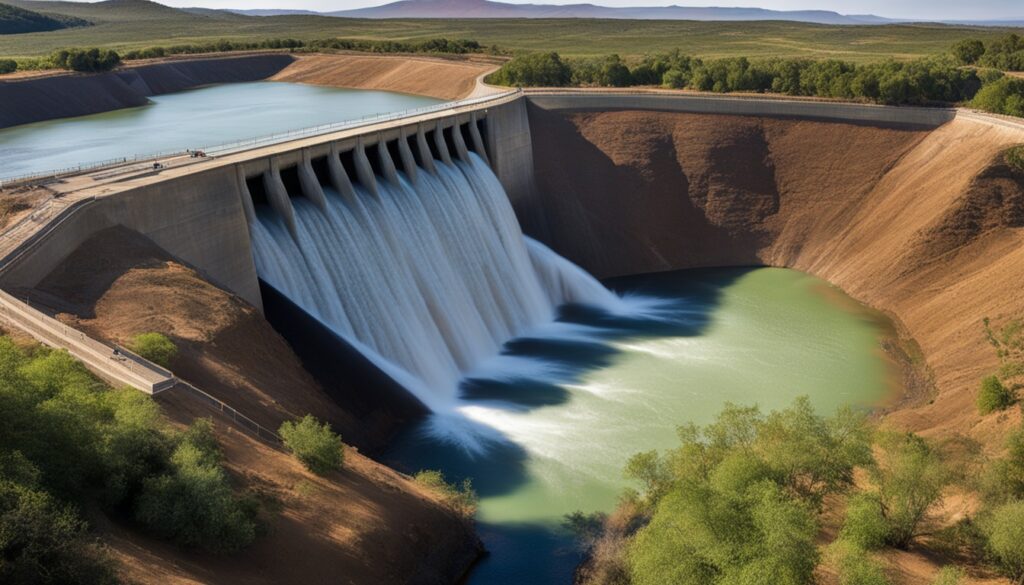
The table below shows key facts and future trends. It highlights the need for better water systems and preparation for water issues:
| Issue | Statistic/Projection |
|---|---|
| Water Withdrawal Rates for Human Use | Reduces ecosystem resilience by limiting tolerance to climate variability |
| Costs for Infrastructure Reconstruction and Maintenance in the U.S. | Trillions of dollars |
| Legal Constraints and Population Growth | Challenges inflexible water systems, heightening vulnerability to climate impacts |
| Surface Water Area Changes in Global Basins | Rapid increases indicative of flooding or declines indicating drying |
We must work hard to manage water better against climate change. Learning about these issues shows that planning ahead and strong structures are fundamental. They help us cope with less water all over the world.
In the face of rising climate change challenges, adopting effective water management is vital. With solid strategies, our water systems can become more resilient and sustainable.
Water scarcity is a major issue globally. Using water efficiently is key to combat this. by applying smart irrigation methods, we can reduce waste and support the environment. Over 40% of the world’s population faces water scarcity, pushing the need for advanced irrigation.
Adapting our water systems to climate changes is crucial. Smart policies and real-time data help manage water better. Yorkshire Water, for example, is using smart tech to keep its water supply reliable despite weather changes. Better use of data, education, and risk planning is necessary for water system resilience.
Making sure water is fairly distributed is essential for everyone’s well-being. All communities should get fair access to water. The 2023 UN Water Conference is a key step in working together to achieve fair water distribution.
These strategies aim to protect our health, wealth, and the planet. The Water for Sustainable Development plan (2018–2028) highlights the need for such actions. By joining forces and planning ahead, we can make our cities and regions strong against climate changes.
To ensure we have enough water in the future, we need to both save water and use it wisely. This is crucial because of issues like climate change, fast-growing cities, and more people needing water. We must act ahead by building strong water systems that resist the effects of a changing climate. Plus, we can use farms that help water stay clean and stores it.
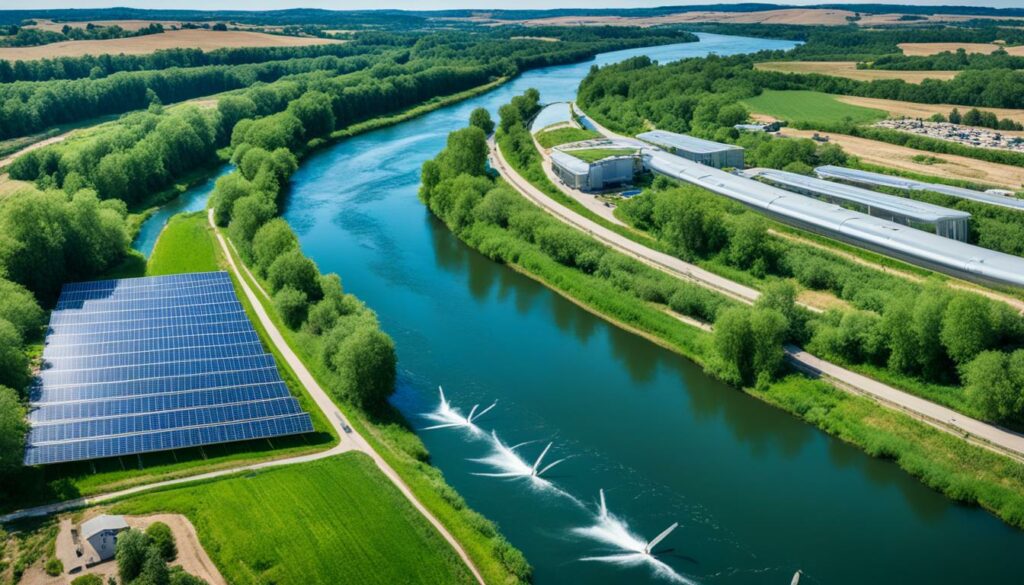
Climate-resilient water supply strategies are essential for keeping us well, wealthy, and our world healthy, especially in places that often face big environmental problems. By using smart farming techniques with AI and computer analysis, we can manage water smarter. Also, new technology that manages water over the internet is making farming with less water, but better results, possible.
Around the world, new and smart water practices are being used more. In San Francisco, they’re growing green roofs and walls to collect rain and keep water clean. Perth has a special way of making its own water that doesn’t rely on the weather, which is key for places with little water. In Merced, they’re turning floods into help for the underground water that everyone needs.
| City | Innovative Practice | Outcome |
|---|---|---|
| San Francisco | Green Infrastructure | Enhanced water security and sustainability |
| Perth | Groundwater Replenishment Scheme | Climate-independent water source |
| Merced | Groundwater Recharge Project | Flood risk reduction and increased groundwater storage |
But it’s not just building things that can help. We should also work with nature. This means using rainwater, making wetlands healthy again, and even farming in cities. These green options make water cleaner and stop floods. They also keep farms working well, even when the weather is crazy.
California is really pushing to make its own water by adding half a million acres of water storage. They’re already starting new projects and are looking to do more. This shows how important it is to manage water well, for now and the future.
Using less water and being smart about how we use it helps us all. It protects our water, cuts the bad effects of a changing climate, and helps our world grow in a good way for our children and their children.
Today, 40 percent of the world faces water scarcity. It’s vital to use technology and new policies for managing water smartly. By using new techniques and policies, we can save water and make sure everyone has fair access to it.
New tech is crucial for using and managing water better. With AI and machine learning, we can guess water needs more accurately. This is super helpful in places where we’re losing a lot of water each year. For example, in some areas, the ground water is disappearing a lot.
Next, we can use nature-based ideas to fight water scarcity. Things like special roads and gardens can help a lot. They’re important because so many areas are seeing big changes in their water, and we need good ways to handle rainwater and stop floods. More and more people might face floods in the future, so we must use the best water management ideas soon.
Having the right rules is just as important as new technology. We need policies that encourage saving water and using it fairly. The whole world is working together to fix these issues. By 2020, countries around the world aim to do better on water and climate issues. The UN is also focusing on improving water problems between 2018 and 2028.
Working together with other countries is key, too. By sharing data and plans, we can make sure water is safer in all areas. It’s also important to spend more on understanding water systems, training experts, and planning for the risks water can bring. This way, local and global efforts on water can match up better.
Big companies use a lot of water and energy to make their products. Governments should encourage them to use less water and sustainable practices. Only a tiny bit of Earth’s water is fresh and clean for us to use. So, we need smart and strong ways to manage water.
Water conservation is key for adapting to our changing climate. Both local efforts and laws are important. They help us deal with water shortages and protect the little freshwater we have left.
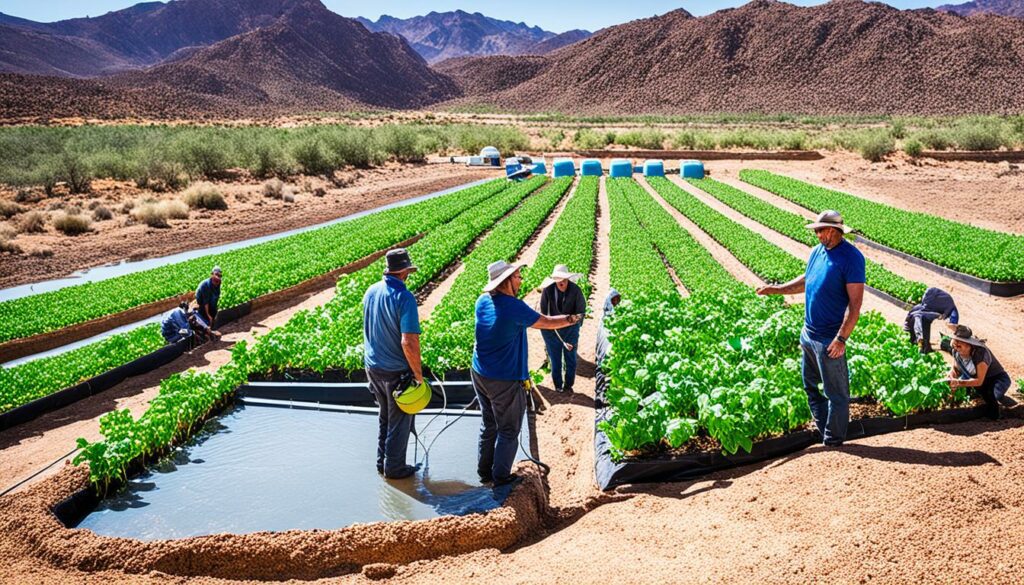
Tackling the drop in water storage needs new approaches and creativity. The world’s water storage is decreasing by 1 cm yearly. This decline shows why we must conserve water better, especially with more people facing severe water shortages over time.
Getting communities involved is vital for adapting to climate change’s impact on water. Teaching people how to save water matters a lot. When everyone works together, we consume less water and keep our local water sources safe.
Government actions are critical to support water conservation. Laws that cut down water use and protect water sources are crucial. Also, governments must educate people about these measures. This way, we ensure enough water for the future and slow down global warming.
Both community involvement and smart laws are essential. They help manage water, fight shortages, and make our water systems stronger against climate change. Starting these efforts now secures a better tomorrow for everyone.
Creating climate-resilient infrastructure is crucial in ensuring steady water supply and dealing with climate change impacts. The main focus is to upgrade our current water systems to be more flexible. By adding climate-resilient water management strategies, we can stand better against the changing climate.
The move to resilient water infrastructure includes a mix of plans. Local governments carry out most of the significant work in OECD countries, investing 69%. Their skills in coping with climate change are key, handling 63% of this spending.
Change must be powered by new ideas. Using systems closer to where the water is used and adding natural elements, like urban wetlands, can help. These solutions reduce flooding and make water cleaner, benefiting the environment greatly.
Getting both public and private money is key for climate-resilient water management. Emerging cities alone might need nearly 30 trillion dollars by 2030. Getting these finances to focus on climate resilience in the long-term is essential.
Investing in resilience pays off. Data from OECD shows spending on resilience could bring back four times the money. Projects like creating flood defences in coastal areas bring huge benefits against climate damage.
Only a small part of climate funds goes to helping countries adapt, just 27% in 2021. Also, not much support at the local level, only 9%, shows we need to rethink where we spend. We need more focus on making places resilient from the start.
Tools for decision-making that handle uncertainties can save a lot of money. Starting with plans that keep climate resilience in mind from the beginning is cheaper in the long term. This mix of getting ready early and using new, nature-based ideas is the way forward for resilient water infrastructure.
Predictive modelling is changing how we manage water in farming. It uses data science, climate knowledge, and new farming methods to get great results. It focuses on water resource management techniques and predictive modelling in agriculture, combining them for big benefits.
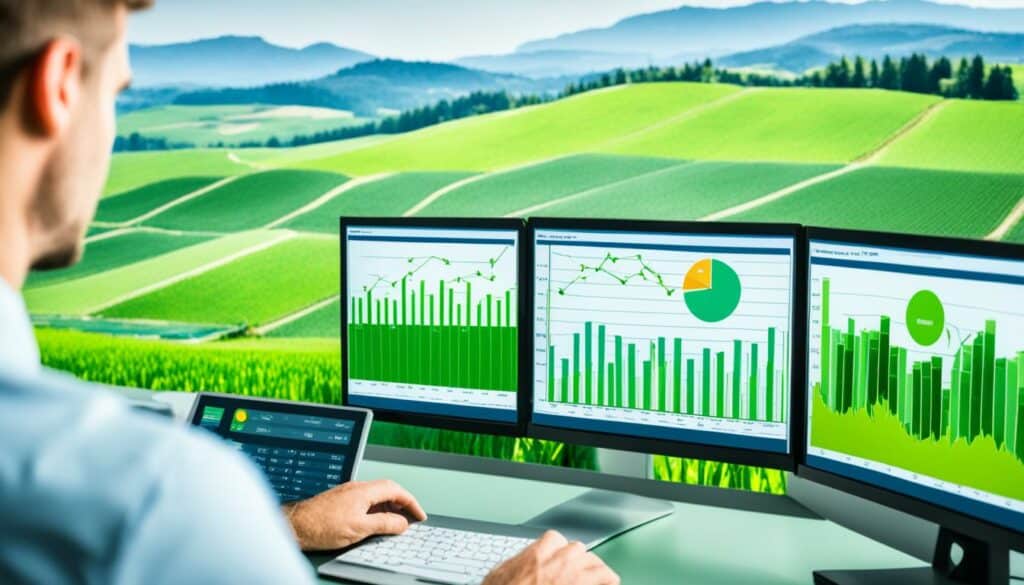
Predictive modelling in agriculture can predict water needs accurately, improving how water is used. It takes data from satellites and weather stations to predict bad weather and climate changes. This helps farmers choose when to plant, what crops to grow, and how much they will yield. It makes managing water better, reducing risks, and increasing productivity.
This tech also helps farmers deal with droughts and too much rain, making water use more efficient. For example, the COALA project in Australia saw a 20% boost in using water wisely. This is key for ensuring there’s enough food and keeping our planet healthy in a changing climate.
Places like Kenya and Ethiopia are using AI in farming to use water and grow crops better. They use smart systems that water plants when they need it, cutting down waste. This has increased crop yields and improved how water is used.
In Mali, they’re also using similar systems to grow more crops efficiently. Tools like soil moisture sensors and IoT devices give real-time updates on the soil. This helps farmers use water in the best way for their crops, boosting both water and crop efficiency.
Predictive analytics plays a huge role in dealing with the impact of climate change. It helps agriculture be ready for unexpected weather. Bringing together experts, policy makers, and tech leaders is essential for using these tools fully. This collaboration is necessary to ensure farming stays sustainable.
| Benefit | Example | Impact |
|---|---|---|
| Optimising Irrigation Schedules | COALA Project, Australia | 20% Improvement in irrigation efficiency |
| Real-time Data for Soil Conditions | AI Systems in Kenya and Ethiopia | Improved water management and crop yields |
| Efficient Water Usage | AI-Powered Drip Irrigation, Mali | Enhanced crop yield and resource efficiency |
Today, predictive modelling and its water management skills are vital in farming. They help farmers deal with the changing climate and thrive.
Using water recycling and replenishing groundwater is vital for managing water sustainably. It’s especially important where water is not in large supply. These methods add to our water sources and improve our readiness for climate change. They do this by lowering the risk of water shortages.
Water recycling helps cut down on water waste and makes our use of water more sustainable. It makes sure we always have enough water for things like farming and industry. By using things like AI and machine learning in water recycling, we can manage water resources better.
In Perth, the Groundwater Replenishment Scheme stands out. It has made a source of water that doesn’t rely on the climate. This means they need less water from the surface. It makes the city stronger against changing climates. San Francisco is also leading the way with green projects. Their green efforts help reuse water and build a more secure water system.
| City | Initiative | Outcome |
|---|---|---|
| Perth | Groundwater Replenishment Scheme | Climate-Independent Water Source |
| San Francisco | Green Infrastructure | Enhanced Water Security |
Advances are happening fast. Innovations like cloud-based water management are making farming more efficient. They also support the move towards farming that uses less water. This and things like vertical farming are shaping how we’ll manage water in farming in the future.
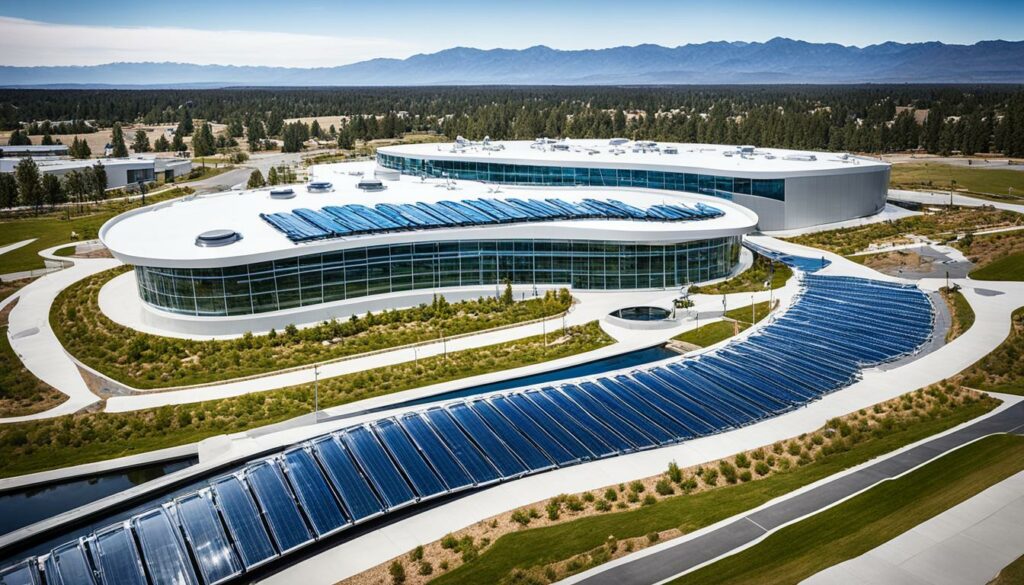
Having strong water systems is key to making sure we always have water, even when the weather changes. To do this, we need systems that can handle a lot and adjust to changes in the weather.
California Water Plan Update 2023 is really important here. It gives $10 million to five areas through the Watershed Resilience Program. This money helps improve how we get water and deals with the effects of a changing climate.
“The California Water Plan Update 2023 outlines seven objectives to guide its vision, including supporting watershed resilience planning, improving resiliency of State, federal, and regional water infrastructure, advancing equitable outcomes in water management, and learning from Tribal water management practices.”
We focus both on the natural places and the things we build to manage water in the Plan. The aim is to repair ecosystems quickly and find the most important areas for our water. These steps are very important to keep our water clean and never run out, even with unpredictable weather.
The Plan also stresses that we should look at what people did in the past to manage water. This means using old and new ideas together. By doing this, we are ready for whatever challenges come our way.
Also, there’s a big talk about new projects and ways to get more funds on April 29, 2024. This shows that the plan is always changing and getting better. Making these efforts is critical to make sure we always have enough water and keep it safe.
Policy makers are crucial in promoting water management that can survive climate change. They create and put into action policies that handle the many issues from climate change.
Developing good policies for water management needs a deep look at our water systems’ problems. With very little usable freshwater threatened by climate change, policies should aim at managing water sustainably. They should ensure fair access and try to lessen climate effects.
An example is the project in La Mojana, Colombia, benefiting over 400,000 people. This shows how specific policies can help a big group. The Colombian government’s Climate Change Adaptation Action Plan is a good foundation for this work.
Yet, there are tough parts in making these water policies work well. Getting everyone to agree on both local and global goals is hard. Finding the money is another big issue. Because of other needs, it’s tough to get the funds for good water management.
Also, working with different groups, like farmers and local people, can be hard. Making policies that everyone agrees with is a challenge. Plus, as the world gets drier and more people need water, working together and funding these efforts is more important than ever.
| Problem | Challenge | Solution |
|---|---|---|
| Water Scarcity | Limited freshwater resources | Craft sustainable management policies |
| Climate Change | Increased variability and extremes | Implement adaptable conservation practices |
| Societal Impact | Aligning local and global objectives | Foster stakeholder collaboration |
To finish, policy makers are key in making our water systems strong against climate change. To attain better water security, we must overcome these challenges by setting common goals, assuring funding, and working together as one.
In the era of climate change, good water management is vital. It’s important to offer people chances to learn about water management. These chances help professionals understand and solve many problems.
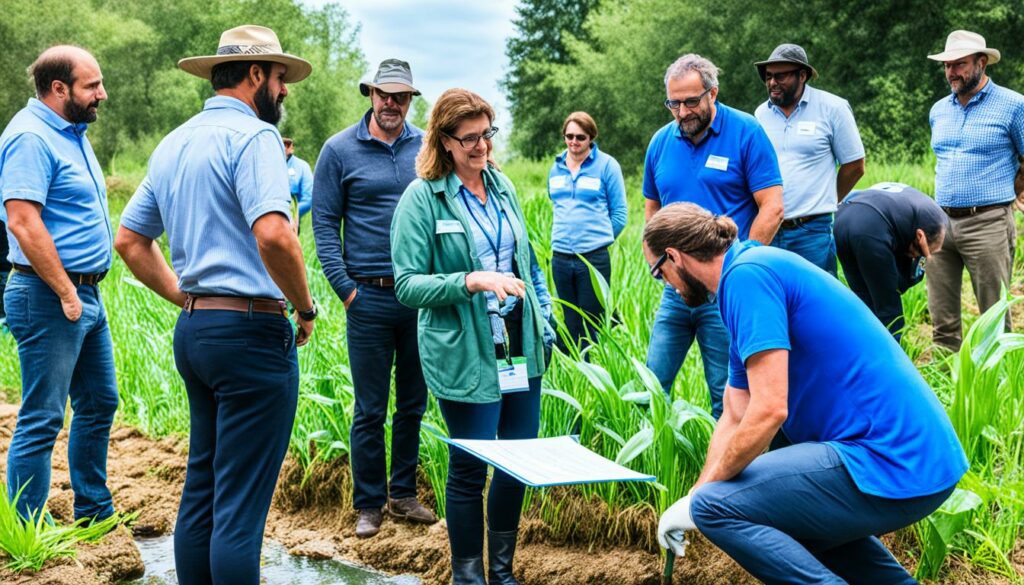
Universities have detailed courses on water management. They join different fields to teach about the latest research and important skills. With events like seminars and projects, scholars get ready to make a difference. This professional development in water management keeps growing with such educational help.
Getting students interested in water management is crucial for the field’s future. Colleges and universities provide places like internships and labs. Students get to use their knowledge in real life. This way, they become more ready for jobs and understand real problems better.
Students also join in events like conferences. They share what they’ve learned and talk to experts in the field. Such activities prepare them to contribute to better water practices and policies.
Looking into professional development in water management opens doors to solve tough water issues better.
Both academics and students have big parts in making water management better. Learning and doing practical projects are key. They help build a team that can find new ways to manage water.
Community-led initiatives are key to good water management. They deal with local needs and foster a sense of responsibility. Big groups like Groundwork USA and River Network show how community engagement in water management matters by talking about it. They even made videos in different languages so more people could understand.
Experts say we should use community projects to save water. They talk a lot about Community-Led Research (CLR). This means working together on projects to fight climate change and help with green city plans. In meetings from July to January, they told us how to fix local nature and be ready for big weather changes.
In Odisha, often hit by droughts and floods, people are working together. They want to build 1000 small places to catch water. They’re also saving a big forest and making 200 clubs. This all helps to use water better and farm smarter, making the community stronger.
There’s a big team called CREWS, with more than 30 groups, that’s a great example. Kresge started it in March 2016. They help make water systems that can handle bad weather, especially in poor and minority areas. This work keeps people safe and their jobs secure.
Climate change has changed the water cycles, making it essential for farmers to use climate-resilient irrigation. By using these methods, farmers can save water and protect their crops from changing weather. They achieve this by using new irrigation methods and learning from successful examples.
There are several new ways to manage water in farming. Drip irrigation is one example, which waters the roots directly, saving water. Rainwater harvesting is also effective, allowing farmers to collect and use rainwater later. It reduces the need for unpredictable rainfall.
Soil moisture sensors provide information on when and how much to water. This helps farmers use water more efficiently.
Looking at a few cases can show us how well these techniques work. In China’s Huang-Huai-Hai Plain, water-saving efforts helped over half a million hectares. This change benefited 1.3 million farming families. It improved water use and made the farmers more money.
Also, schemes like RDI in Spain have helped produce maize in a water-friendly way. They use less water and keep water sources safe. These studies show that during droughts, it’s possible to use water smartly while protecting the environment.
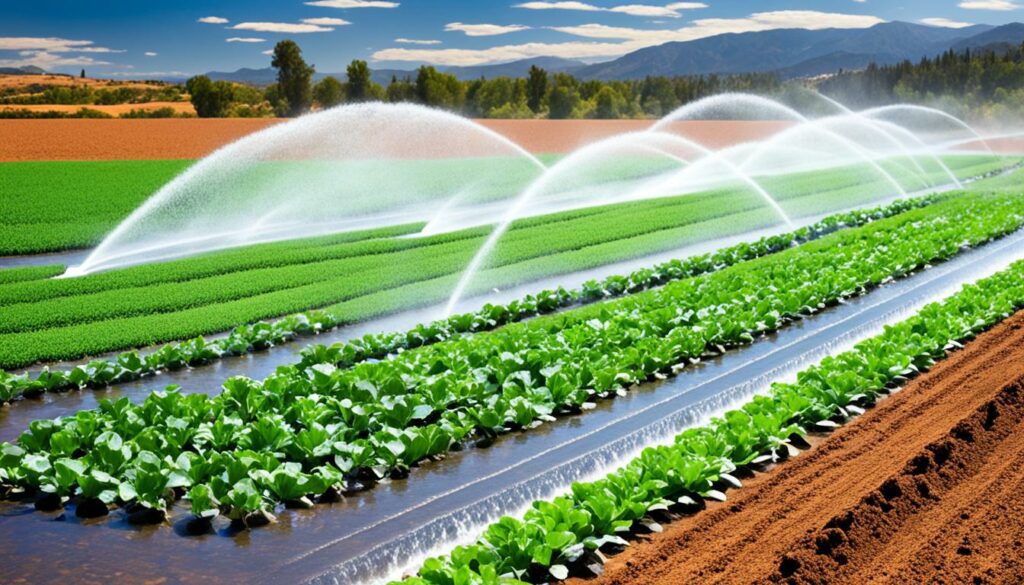
In Nevada’s Walker River Basin, they increased reservoir storage. This stopped water problems from hitting farm incomes. The success in these places shows that smart irrigation is key to lasting farming and saving water.
| Technique | Region | Benefit | Number of Beneficiaries |
|---|---|---|---|
| Drip Irrigation | Global | Reduces evaporation losses | Varies by deployment |
| Rainwater Harvesting | Global | Reduces rain dependence | Varies by deployment |
| Soil Moisture Sensors | Global | Optimises water use | Varies by deployment |
| Water-saving measures | Huang-Huai-Hai Plain, China | Improved efficiency | 1.3 million families |
Using these methods can make farming more sustainable. It helps farmers cope with water challenges caused by climate change.
The future in handling water against climate issues needs smart approaches and green practices. Over 90 percent of global disasters are water-related. This fact alone shows how urgent it is to improve our water management schemes.
About 40 percent of people around the world don’t have enough water. Smart use of technology and quick data help manage water better. Cities like Singapore and Melbourne are leading the way with smart water systems.
The UN’s “International Decade for Action – Water for Sustainable Development” is from 2018 to 2028. This shows the world’s shared goal of managing water sustainably through teamwork and by involving everyone.
More floods due to climate change can destroy water supplies and sanitation. Using natural methods, like building urban wetlands, can clean water and reduce flood risks. This shows how water and climate plans can work together for the better.
Policies that make everyone responsible are very important. For example, Yorkshire Water is using smart tech to face climate challenges. This means building water systems that can handle weird weather and water shortages.
LinkedIn groups like Urban Water Security and Nature-Based Solutions are helping share knowledge. Schools and the UN are also working together for the Water Action Decade. This is a key part of improvi
Getting 30% off on funding water projects by Oxford University Press is a big help. It encourages using new, green water methods. Together, moving towards eco-friendly water solutions saves water for us and our planet. Plus, it makes us stronger against the changes that come with climate change.
Climate-resilient water management is key for our future. It secures resources and supports development. Insights from the Global Workshop showed the need to blend water, sanitation, and regional plans with national climate strategies. Countries like Bangladesh and Italy spotlight how to tackle climate’s effects on water and health to boost resilience.
The workshop showcased key efforts. The Moldovan-Ukrainian project on the Dniester River managed floods well. Also, the Adaptation Fund improved joint flood and drought responses in Drin and Volta River basins. These cases prove cooperative efforts are vital for strong water management against climate challenges.
Global warming is a pressing concern. Temperatures could rise by 1.5°C in the next 20 years. This means there’ll be less water and countries, like India, might face economic losses. Bold actions and support are demanded to reduce these impacts.
Most national climate plans put water adaptation top of their list. So, including resilient water systems and better WASH services is crucial for health and sustainability. The Water and Health Protocol and upcoming climate talks stress the importance of working together. We must secure our future by managing water against climate change.
This means making water systems stronger against climate changes. It aims to use water sustainably and share it fairly.
It’s key due to climate change and more people needing water. It’s vital for life, work, and making food and energy.
Climate change shifts how water moves, making water scarce and harder to manage. Most disasters are water-related. This highlights the need for joined water and climate policies.
Key methods include using resources better, making systems stronger against climate changes, and ensuring everyone can get to water equally.
These include saving water, updating systems, and using farming methods that keep water resources strong over time.
By using new tech like AI and making green spaces to cope with less water. We also need new rules to use water more fairly.
Local people getting involved helps everyone care more about water. This leads to new ways to save water and makes communities stronger against water and climate problems.
It ensures we have enough water in the future by making current systems stronger. Adding green spaces helps and building smaller water systems helps local areas more.
It can predict how much water we’ll need, when to water plants, and make smart decisions about too much or too little rain. This makes water use smarter and farms more productive.
These ways create more water, reduce the risk of not having enough, and rely less on changing surface water. Perth’s scheme is a good example.
Policymakers create and carry out rules for water that make us ready for climate changes. They help solve water problems by fostering good care and use of water.
Schools give chances to learn and research for students. For professionals, there are webinars, conferences, and hands-on experiences to tackle big water challenges.
Local projects help people get involved and protect water. They find new ways to save water and stay strong against water shortages and climate changes.
These ways use smart techniques that need less water and can handle different climate conditions. They help farming stay strong and save water.
The future needs new ideas, rules, and ways to learn that protect water for everyone. This helps communities, economies, and the environment stay safe from changing climates.